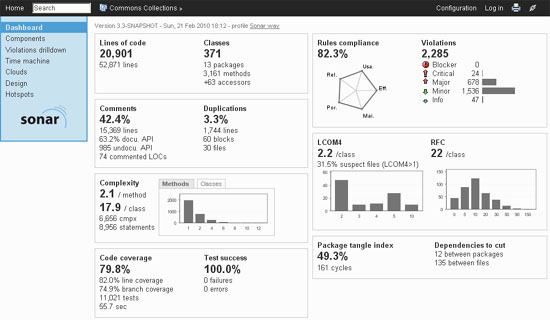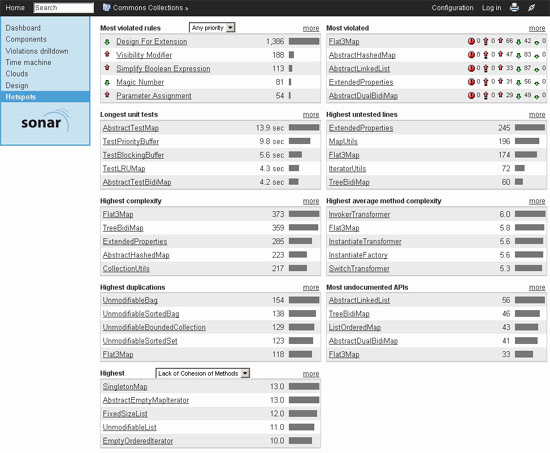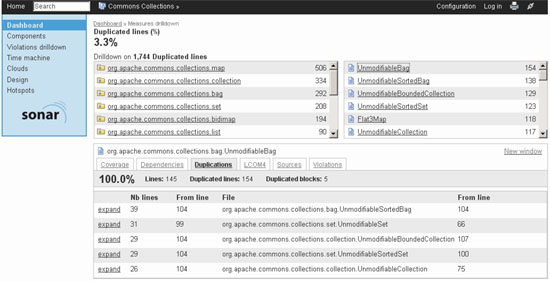Step By Step Procedure to Configure Sonar for MYSQL:
Please follow the link to configure the Sonar with MySql:
http://docs.codehaus.org/display/SONAR/Installing+Sonar
Step1:Download Sonar 2.11 From Website
Step2: Copy The Folder and Extract the Folder
Step3: Down Load and Install MYSQL(5.1) server
And create the database for the same.(for creating sample database please click https://github.com/SonarSource/sonar/blob/master/sonar-application/src/main/assembly/extras/database/mysql/create_database.sql)
Step4: In D:/sonar-2.11\conf\sonar.properties file
Uncomment below code: For MySql
Please follow the link to configure the Sonar with MySql:
http://docs.codehaus.org/display/SONAR/Installing+Sonar
Step1:Download Sonar 2.11 From Website
Step2: Copy The Folder and Extract the Folder
Step3: Down Load and Install MYSQL(5.1) server
And create the database for the same.(for creating sample database please click https://github.com/SonarSource/sonar/blob/master/sonar-application/src/main/assembly/extras/database/mysql/create_database.sql)
Step4: In D:/sonar-2.11\conf\sonar.properties file
Uncomment below code: For MySql
sonar.jdbc.url: jdbc:mysql://localhost:3306/sonar?useUnicode=true&characterEncoding=utf8sonar.jdbc.driverClassName: com.mysql.jdbc.Driversonar.jdbc.validationQuery: select 1
Then Start the Sonar and check the log file:
to Start the Sonar:
D:/sonar-2.11\bin\windows-x86-32/StartSonar.bat
run the StartSonar.bat from console.
And also copy the extensions folder with customized rules.xml under the D:\sonar-2.11 directory(overwrite the extension folder)
Then........
Download the sonar-runner-1.3 form WebSite
Copy the sonar-runner-1.3 zip folder and extract the same.
Then Edit the D:\sonar-runner-1.3\conf\sonar-runner.properties
i.e Uncomment the MySql code.
And Create the sonar-project.properties file and put this file under D:\sonar-runner-1.3\bin directory.
D:\sonar-2.11\conf\sonar.properties:
#--------------------------------------------------------
# To use an environment variable, use the following syntax : ${env:NAME_OF_ENV_VARIABLE}
# For example :
# sonar.jdbc.url: ${env:SONAR_JDBC_URL}
#
#
# See also the file conf/wrapper.conf for JVM advanced settings
#---------------------------------------------------------
#---------------------------------------------------------
# WEB SETTINGS - STANDALONE MODE ONLY
# These settings are ignored when the war file is deployed to a JEE server.
#---------------------------------------------------------
# Listen host/port and context path (for example / or /sonar). Default values are 0.0.0.0:9000/.
#sonar.web.host: 0.0.0.0
#sonar.web.port: 9000
#sonar.web.context: /
# Log HTTP requests. Deactivated by default.
#sonar.web.jettyRequestLogs: ../../logs/jetty-yyyy_mm_dd.request.log
# Apache mod_jk connector. Supported only in standalone mode.
# Uncomment to activate AJP13 connector.
#sonar.ajp13.port: 8009
#-----------------------------------------------------------------------
# DATABASE
#
# IMPORTANT : the embedded database Derby is used by default.
# It is recommended for tests only. Please use an external database
# for production environment (MySQL, Oracle, Postgresql, SQLServer)
#
#-----------------------------------------------------------------------
#----- Credentials
# Permissions to create tables and indexes must be granted to JDBC user.
# The schema must be created first.
sonar.jdbc.username: sonar
sonar.jdbc.password: sonar
#----- Embedded database Derby
# Note : it does accept connections from remote hosts, so the
# sonar server and the maven plugin must be executed on the same host.
# Comment the following lines to deactivate the default embedded database.
#sonar.jdbc.url: jdbc:derby://localhost:1527/sonar;create=true
#sonar.jdbc.driverClassName: org.apache.derby.jdbc.ClientDriver
#sonar.jdbc.validationQuery: values(1)
# directory containing Derby database files. By default it's the /data directory in the sonar installation.
#sonar.embeddedDatabase.dataDir:
# derby embedded database server listening port, defaults to 1527
#sonar.derby.drda.portNumber: 1527
# uncomment to accept connections from remote hosts. Ba default it only accepts localhost connections.
#sonar.derby.drda.host: 0.0.0.0
#----- MySQL 5.x/6.x
# Comment the embedded database and uncomment the following properties to use MySQL. The validation query is optional.
#sonar.jdbc.url: jdbc:mysql://localhost:3306/sonar?useUnicode=true&characterEncoding=utf8
#sonar.jdbc.driverClassName: com.mysql.jdbc.Driver
#sonar.jdbc.validationQuery: select 1
sonar.jdbc.url: jdbc:mysql://localhost:3306/sonar?useUnicode=true&characterEncoding=utf8
sonar.jdbc.driverClassName: com.mysql.jdbc.Driver
sonar.jdbc.validationQuery: select 1
#----- Oracle 10g/11g
# To connect to Oracle database :
#
# - It's recommended to use the latest version of the JDBC driver (either ojdbc6.jar for Java 6 or ojdbc5.jar for Java 5).
# Download it in http://www.oracle.com/technetwork/database/enterprise-edition/jdbc-112010-090769.html
# - Copy the driver to the directory extensions/jdbc-driver/oracle/
# - Comment the embedded database and uncomment the following properties. The validation query is optional.
#
#sonar.jdbc.url: jdbc:oracle:thin:@localhost/XE
#sonar.jdbc.driverClassName: oracle.jdbc.driver.OracleDriver
#sonar.jdbc.validationQuery: select 1 from dual
# Uncomment the following property if multiple Sonar schemas are installed on the same server
# (for example with different versions).
# In that case, use the same property during project analysis (-Dsonar.hibernate.default_schema=<schema>)
#sonar.hibernate.default_schema: sonar
#----- PostgreSQL 8.x, 9.x
# Uncomment the following properties to use PostgreSQL. The validation query is optional.
#sonar.jdbc.url: jdbc:postgresql://localhost/sonar
#sonar.jdbc.driverClassName: org.postgresql.Driver
#sonar.jdbc.validationQuery: select 1
# If the PostgreSql database contains several schemas, the following property must define the schema to be used
#sonar.jdbc.postgreSearchPath: public
#----- Microsoft SQLServer
# The Jtds open source driver is available in extensions/jdbc-driver/mssql. More details on http://jtds.sourceforge.net
# The validation query is optional.
#sonar.jdbc.url: jdbc:jtds:sqlserver://localhost;databaseName=SONAR;SelectMethod=Cursor
#sonar.jdbc.driverClassName: net.sourceforge.jtds.jdbc.Driver
#sonar.jdbc.validationQuery: select 1
#----- Connection pool settings
sonar.jdbc.maxActive: 25
sonar.jdbc.maxIdle: 5
sonar.jdbc.minIdle: 2
sonar.jdbc.maxWait: 5000
sonar.jdbc.minEvictableIdleTimeMillis: 600000
sonar.jdbc.timeBetweenEvictionRunsMillis: 30000
#---------------------------------------------------------
# UPDATE CENTER
#---------------------------------------------------------
# The Update Center requires an internet connection to request http://update.sonarsource.org
# It is activated by default:
#sonar.updatecenter.activate=true
# HTTP proxy (default none)
#http.proxyHost=
#http.proxyPort=
# NT domain name if NTLM proxy is used
#http.auth.ntlm.domain=
# SOCKS proxy (default none)
#socksProxyHost=
#socksProxyPort=
# proxy authentication. The 2 following properties are used for HTTP and SOCKS proxies.
#http.proxyUser=
#http.proxyPassword=
#---------------------------------------------------------
# NOTIFICATIONS
#---------------------------------------------------------
# Delay (in seconds) between processing of notification queue
sonar.notifications.delay=60
sonar-project.properties:
# required metadata
sonar.projectKey=my2:project
sonar.projectName=AQM_LIB
sonar.projectVersion=1.0
# path to source directories (required)
#sources=D:\\Projects\\Cloud-Migration-POC\\Cust-Supp-Artf\\AQMLatest_SourceCode\\AQM_LIB_5.0
sources=D:\\WorkSpace\\GWTProj\\cloud_migration\\aqm_lib\\src\\java
#D:\WorkSpace\GWTProj\cloud_migration\aqm_lib
# path to test source directories (optional)
#tests=testDir1,testDir2
# path to project binaries (optional), for example directory of Java bytecode
#binaries=binDir
# optional comma-separated list of paths to libraries. Only path to JAR file and path to directory of classes are supported.
#libraries=path/to/library.jar,path/to/classes/dir
# Uncomment those lines if some features of java 5 or java 6 like annotations, enum, ...
# are used in the source code to be analysed
sonar.java.source=1.5
sonar.java.target=1.5
# Uncomment this line to analyse a project which is not a java project.
# The value of the property must be the key of the language.
#sonar.language=cobol
# Advanced parameters
my.property=value
1.Run Sonar And
2.Then run the sonar-runner-1.3\bin\sonar-runner.bat from console.
3.type http://localhost:9000 in browser
and click on configuration....
D:\SANA_S\Soft\sonar-runner-1.3\conf\sonar-runner.properties file:
#----- Default Sonar server
#sonar.host.url=http://localhost:9000
#----- PostgreSQL
#sonar.jdbc.url=jdbc:postgresql://localhost/sonar
#sonar.jdbc.driver=org.postgresql.Driver
#----- MySQL
sonar.jdbc.url=jdbc:mysql://localhost:3306/sonar?useUnicode=true&characterEncoding=utf8
sonar.jdbc.driver=com.mysql.jdbc.Driver
#----- Oracle
#sonar.jdbc.url=jdbc:oracle:thin:@localhost/XE
#sonar.jdbc.driver=oracle.jdbc.driver.OracleDriver
#----- Global database settings
#sonar.jdbc.username=sonar
#sonar.jdbc.password=sonar
#----- Default directory layout
#sources=src/main/java
#tests=src/test/java
#binaries=target/classes
sonar.sourceEncoding=UTF-8
Related Sites:




